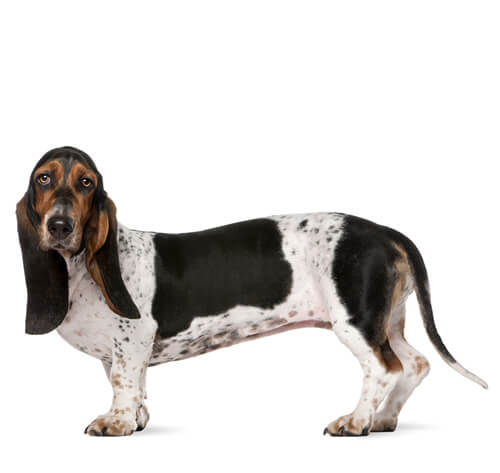
With his short legs, long ears and soulful eyes, the Basset Hound is easily recognised. This good-natured and affectionate breed gets along well with children and other dogs. The Basset Hound is an exceptional scenthound used to hunt rabbits, birds, fox, and deer. This breed easily puts on weight, so owners should avoid overfeeding and be sure their Basset receives regular exercise.
DID YOU KNOW? The Basset Hound may have developed from genetic dwarf dogs from litters of French hunting hounds. In French, the word “bas” means “low.”
ALSO KNOWN AS: Basset, Hush Puppy
The need-to-know
- Dog suitable for owners with some experience
- Some training required
- Enjoys active walks
- Enjoys walking an hour a day
- Medium dog
- Minimum drool
- Requires grooming every other day
- Non hypoallergenic breed
- Very vocal dog
- Not a guard dog
- May require training to live with other pets
- Great family dog
Personality

Despite looking morose and serious, the Basset Hound dog breed is sociable, calm, polite and quietly playful. Affectionate with people they know and reserved with others, they love children and get on well with other dogs and with some training, other animals in the home. They are very companionable dogs who hate to be left alone and so always need some company - whether human or canine.
History and Origins

Country of Origin: France
The Basset Hound originated in France where they were used to hunt rabbit, hare and wild boar, and the name ‘basset’ translates to ‘short’ or ‘low’.Their history is somewhat accidental coming from short-legged mutations appearing in traditional scent hound breeds. Rather than rejecting these dogs, it became clear that they were useful for hunters who were following dogs on foot rather than horseback and couldn’t move as fast. Often this was because there was heavy cover where horses couldn’t go or else poverty following the French Revolution meant that many people could no longer afford horses.The Basset Hound came to England in 1866 where it was crossed with the Bloodhound to give a heavier bodied version than the original French dog - and this is the Basset Hound we see today.
Nutrition and Feeding

Your dog's diet needs to have the right balance of all the main nutrient groups including a constant supply of fresh water. It's also important to conduct regular?body condition?scores to ensure you keep your dog in ideal shape and remember to feed them at least twice daily and in accordance with the feeding guidelines of their particular food. The deep-chested Basset is prone to bloating and stomach problems; smaller, more frequent meals can help minimise this risk.
Exercise

About an hour's daily exercise is needed. Basset Hounds can tend to be lazy if given half a chance, but they do need exercise to ensure they do not put on too much weight, which can cause back problems in later life. During the rapid growth periods, however, exercise must be limited as joint complications may occur. Because of the length of their bodies, Bassets should not be allowed to go up and down stairs until they are 18 months old. As well as walking exercise, regular/daily scent work enrichment is a real joy for these dogs.
Other Information

Health and common issues
The most common health problems seen in the Bassett Hound are related to their body shape. They are prone to spinal disorders and abnormal joint development, particularly of the elbows, and obesity can make these disorders more problematic. They are also predisposed to ear and skin infections, as well as various eye conditions and so should be regularly assessed for these.
Space requirements
The Basset Hound is very much a country dog as, while they don’t need a huge amount of exercise, they do need daily country walks where they can get to use their incredible nose. Much of the joy of exercise for a Basset Hound is following scents and sniffing - so owners need to be able to indulge them in that and enjoy watching them, and not get frustrated. They enjoy having their own garden to wander around and sniff in too. Given their joy of howling, it’s best if you don’t have close neighbours!
Training basset hounds
The Basset Hound looks on training with some amusement and largely feels it is a pointless exercise. As they tend to go deaf when they find a great scent, training them to walk on a harness and lead is important as once in the great outdoors their recall is likely to be less than reliable, no matter how much time you spend training. The Basset Hound excels is in scent work so find a training class that will help you explore and celebrate your dog’s strengths and never focus on their training failings. Separation related problems can be an issue if they are left alone without company.
Best family dog breeds
Basset Hounds make wonderful family dogs as they are kind and patient as well as being friendly to all. It is important however that children are taught not to take advantage of this good nature. While many dogs are traditionally thought of as being good with children, all dogs and children need to be taught to get on with and respect each other, and be safe together. Even so, dogs and young children should never be left alone together and adults should supervise all interactions between them.
Did you know?
- The Basset Hound has found fame in a variety of unexpected places - including advertising Hush Puppy shoes and also in the cartoon character of Fred Basset.
- Basset Hounds are the second-best sniffers in the canine world, second only to the Bloodhound.
- This dog breed has difficulty swimming because of their small legs and dense bodies.
- Marilyn Monroe had a Basset Hound called Hugo.
- Their long, floppy ears help to lift scents off the ground right to their nose to help them track things better.